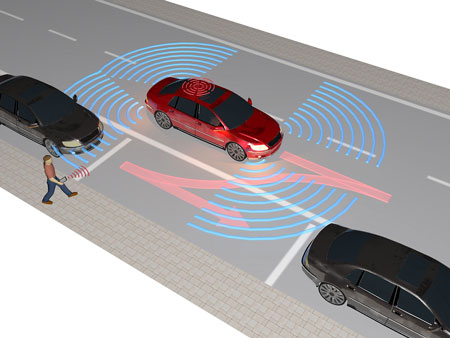| Nov 12, 2014 |
Electric cars without drivers
|
|
(Nanowerk News) E-Mobile will park independently in the future and will also be able to find the next charging station without a driver. Researchers are working on electric cars that can travel short distances autonomously. On the basis of cost-effective sensors, they are developing a dynamic model that perceives the environmental situation.
|
|
Whoever got his driver’s license twenty years ago and is back in a car for the first time is going to be rubbing his eyes in amazement. Electronic helpers warn of a possible collision when parking and keep the necessary distance to the car ahead during traffic. There are lane departure, crosswind, blind spot and high beam assistants, not to mention the anti-lock system. The car is taking over step by step in the cockpit. Researchers at the Fraunhofer Institute for Manufacturing Engineering and Automation IPA are one step ahead: They are dedicated to automated driving and are working on the vehicles of tomorrow, which can drive through traffic without human assistance. In this process, the Stuttgart engineers are particularly keeping an eye on electric cars.
|
 |
| Autonomous vehicle in the car-sharing operation: After the renter has called for the car, it navigates autonomously to the pick-up area. (Image: Fraunhofer IPA)
|
|
The specialty of the researchers at the IPA is the development of robots. In the institute building, there is a prototype that independently finds its way on its four wheels through unknown territory. The challenges that are to be mastered are similar to those for automated driving. Here, as well, sensors need to recognize the environment so that the vehicle can navigate around obstacles and find its goal. Why not take advantage of that experience and apply it to the car, say the engineers in Stuttgart. That is why, one and a half years ago, an interdisciplinary team of computer scientists, mathematicians, electrical engineers and mechatronics engineers launched the project Afkar (a German abbreviation for “autonomous driving and intelligent chassis concept for an all-electric vehicle”).
|
|
In a first step, the electric car is intended to learn to find a parking space and to park without a scratch. The idea behind this is that the car should be able to recharge itself with electricity without human help. This would be particularly important for car-sharing. Imagine the following scenario: The driver easily parks the car in a properly equipped parking garage on any randomly available parking space. The car takes care of everything else itself. It communicates via a wireless interface with the charging station and the parking garage management. In this process, it provides information about its charge level and its location. If the battery is empty and a charging station is free, it maneuvers in the corresponding parking bay and is charged inductively, without a cable. Then it makes room for the next electric car and rolls to a free parking space. In this way, the few existing charging stations can be used effectively.
|
|
Necessary technology is available
|
|
“The technology needed for this scenario is already available,” says Afkar project manager Benjamin Maidel. He is referring to the robots of the institute that find their way easily in a known environment, such as a factory floor. Rebuilding a similar car does not take a lot of effort. Many modern cars already have most of the sensors that are required for this. The data that these devices collect just have to be combined and interpreted accordingly so that they provide a picture of the environment. The Fraunhofer experts are currently developing the necessary technology with the help of complex simulation programs. Soon, they want to test the results in practice on a demonstration vehicle.
|
|
It becomes more difficult when a car is intended to move autonomously in traffic. This requires sensors that can look hundreds of meters ahead as well as software that can react to any unforeseen events, whether that’s a building site, a thunderstorm or snow. Maidel and his team are focusing on cameras, ultrasound, radar and laser scanners that perceive the surrounding area up to a distance of 200 to 300 meters.
|
|
The Afkar group will first go with their test car to a cordoned-off test area. For public roads, a special permit is required. “Whether autonomous driving makes a breakthrough will be decided, along with the right price, by customer acceptance and the legal framework. For example, the liability for accidents has to be re-regulated. The technology will probably conquer the market step by step”, says Maidel. The advantages are obvious – particularly for car-sharing vehicles. Any customer could use his smart phone to call a car, which would then drive to the desired location. Car-sharing companies could utilize their fleets more fully than they do today.
|

